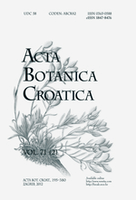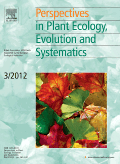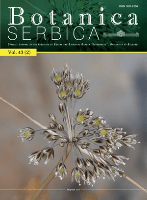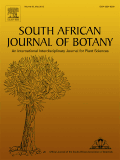
ACTA BOTANICA CROATICA
Scope & Guideline
Championing Cutting-edge Discoveries in Plant Biology
Introduction
Aims and Scopes
- Plant Systematics and Taxonomy:
The journal publishes research that clarifies the taxonomic relationships among plant species, contributing to the understanding of biodiversity and the systematics of various plant families. - Ecological and Environmental Studies:
Research on plant communities, their composition, and the ecological impacts of environmental changes, such as succession and species invasions, is a core focus area. - Physiological and Biochemical Plant Responses:
Studies examining how plants respond physiologically and biochemically to abiotic stresses (e.g., salinity, drought) and biotic interactions (e.g., with fungi or other plants) are prevalent. - Conservation and Endemism:
The journal highlights research on endemic species and conservation issues, particularly in the Balkan region, addressing the importance of preserving plant diversity. - In vitro and Biotechnological Applications:
Papers covering in vitro propagation methods and biotechnological applications for plant conservation and improvement are frequently included.
Trending and Emerging
- Genetic and Molecular Studies:
There is a notable increase in research utilizing molecular techniques, such as DNA fingerprinting and gene expression analyses, to understand plant diversity and responses to environmental stressors. - Ecophysiological Responses to Climate Change:
Studies focusing on how plants respond to climate change-related stressors, such as drought and salinity, are becoming more prominent, highlighting the importance of understanding plant adaptability. - Urban Flora and Vegetation Studies:
With urbanization on the rise, there is a growing interest in studying urban flora and vegetation dynamics, particularly how plants adapt to urban environments and their ecological roles. - Fungal-Plant Interactions:
Research on the relationships between plants and their fungal associates, including endophytes and mycorrhizae, has gained traction, reflecting an interest in understanding these complex interactions and their ecological significance.
Declining or Waning
- Marine and Aquatic Botany:
Research focusing on marine and aquatic plant species, such as algae and phytoplankton, seems to have decreased, suggesting a potential shift away from these topics in favor of terrestrial plant studies. - Traditional Medicinal Plants:
Although previously a popular subject, studies on the ethnobotanical uses and traditional medicinal properties of plants have become less frequent, possibly overshadowed by more contemporary ecological and physiological research. - Invasive Species Research:
While some studies on invasive species continue, the overall focus on their impacts and management appears to be waning, indicating researchers may be prioritizing other ecological topics. - Morphological Studies:
Detailed morphological studies of plant taxa, which used to be a significant area of interest, are less common now, possibly due to the rise of molecular and genetic approaches in plant research.
Similar Journals

PERSPECTIVES IN PLANT ECOLOGY EVOLUTION AND SYSTEMATICS
Fostering Dialogue in Plant Science ResearchPERSPECTIVES IN PLANT ECOLOGY, EVOLUTION AND SYSTEMATICS is a premier scientific journal published by Elsevier GmbH, dedicated to advancing knowledge and understanding in the fields of plant ecology, evolution, and systematics. With an impressive impact factor and a solid reputation within the top quartile (Q1) of both Ecology and Plant Science categories, this journal ranks among the elite, positioned 100th out of 721 journals in its field, reflecting its significant contribution to ongoing research and academic dialogue. Established in 1998 and converging through to 2024, this journal not only serves as a crucial platform for researchers, professionals, and students alike but also emphasizes innovative methodologies and interdisciplinary approaches to address pressing environmental issues. Although it follows a traditional access model, the wealth of rigorous peer-reviewed articles available will engage the scientific community and facilitate advancements in understanding plant diversity and ecological interactions.

Botanica Serbica
Exploring the rich diversity of botanical research.Botanica Serbica is an esteemed open-access journal published by the University of Belgrade's Institute of Botany and Botanical Garden, aimed at advancing the field of plant science. With an ISSN of 1821-2158 and E-ISSN of 1821-2638, the journal has been contributing to the dissemination of knowledge since 2009, providing a platform for researchers, professionals, and students in Serbia and beyond to share original research, reviews, and insightful discussions on various aspects of botany. Botanica Serbica holds a respectable position in the academic community, currently ranked in the Q3 quartile for Plant Science according to the 2023 category quartiles, placing it within the competitive landscape of agricultural and biological sciences. Its Scopus ranking of #359 out of 516 further emphasizes its relevance and accessibility within the scientific discourse. With converged years from 2013 to 2024, this journal continually focuses on increasing awareness and understanding of plant biology, ecology, and conservation, making it a vital resource for anyone engaged in botanical studies.

SOUTH AFRICAN JOURNAL OF BOTANY
Advancing Plant Science Through Rigorous ResearchThe SOUTH AFRICAN JOURNAL OF BOTANY, published by Elsevier, is a distinguished peer-reviewed journal that serves as an essential platform for the dissemination of high-quality research in the field of plant science. With an ISSN of 0254-6299 and an E-ISSN of 1727-9321, this journal has been a vital contributor to the scientific community since its inception in 1982, continuing to publish pivotal research findings up to 2024. Recognized in the Q2 category of Plant Science for 2023, and ranked 106 out of 516 in Scopus, this journal occupies the 79th percentile in its field, reflecting a strong commitment to advancing botanical sciences. Although it is not an open-access publication, it provides crucial insights and advancements that benefit researchers, professionals, and students alike. As the journal continues to evolve, it remains an invaluable resource for those dedicated to exploring the complexities of plant biology within the broader scope of agricultural and biological sciences.

BOTANICAL JOURNAL OF THE LINNEAN SOCIETY
Unveiling the Complexity of Flora and Fauna InteractionsThe Botanical Journal of the Linnean Society, published by Oxford University Press, stands as a premier platform for interdisciplinary research within the realms of Ecology, Evolution, Behavior, and Plant Science. With a notable impact factor reflective of its esteemed reputation, this journal is classified in the Q1 quartile for both Ecology and Plant Science, placing it among the most influential publications in these fields. Since its inception in 1969, and with an anticipated convergence of research extending to 2024, it has become essential for scholars and professionals seeking to engage with cutting-edge studies, theoretical frameworks, and practical applications that drive our understanding of plant biology and ecological systems. The journal’s commitment to excellence is underscored by its robust Scopus rankings—achieving an impressive 83rd percentile in Ecology and a 82nd percentile in Plant Science. This makes the Botanical Journal of the Linnean Society a crucial resource for researchers, educators, and students alike, eager to advance their knowledge and contribute to the evolving discourse in botany and environmental studies.

ANNALS OF BOTANY
Cultivating Innovations in Plant ResearchANNALS OF BOTANY, published by Oxford University Press, stands as a leading journal in the field of Plant Science, with a distinguished history that dates back to 1887. This esteemed journal, recognized for its contribution to the advancement of botanical research, holds a prestigious Q1 quartile ranking in its category as of 2023. With a commitment to sharing high-quality, peer-reviewed research, ANNALS OF BOTANY provides a vital platform for researchers, professionals, and students to disseminate novel findings and engage in scholarly discourse. Although it does not currently offer open access options, the journal remains accessible to a wide academic audience, further cementing its role in facilitating the exchange of knowledge within the global botanical community. For those interested in the dynamic and evolving world of plant sciences, ANNALS OF BOTANY is an indispensable resource.

Alpine Botany
Innovating Research in Alpine Botanical Science.Alpine Botany is a premier scholarly journal published by SPRINGER BASEL AG, dedicated to the field of ecological and botanical research with a specific focus on alpine environments. With an ISSN of 1664-2201 and an E-ISSN of 1664-221X, this journal has established itself as a significant platform for disseminating high-quality research findings, with its latest category rankings placing it in the Q1 quartile for both Ecology, Evolution, Behavior and Systematics as well as Plant Science. Originating from Switzerland, Alpine Botany benefits from its geographical context, fostering a rich exchange of ideas and research advancements relevant to high-altitude flora. The journal operates under an Open Access model, promoting widespread accessibility of its content while accommodating an increasing demand for interdisciplinary studies within the ecological and botanical communities. With a commitment to excellence, Alpine Botany continues to serve as an invaluable resource for researchers, professionals, and students who are keen to explore and understand the complexities of alpine ecosystems.

Botanical Studies
Unlocking the Secrets of the Plant KingdomBotanical Studies is a premier open-access journal published by Springer, dedicated to the field of botany and plant sciences. Since its establishment in 2006, the journal has championed innovative research and scholarship that explores diverse botanical topics ranging from plant systematics to ecology and conservation. With a commitment to broad accessibility, it promotes the dissemination of knowledge to researchers, professionals, and students worldwide. Botanical Studies fosters academic collaboration and dialogue, contributing significantly to the global botanical community. Its open-access policy allows unrestricted access to its high-quality, peer-reviewed content, ensuring that vital research is available to all. Join the growing community of scholars advancing botanical science through this essential publication, conveniently located at One New York Plaza, Suite 4600, New York, NY 10004, United States.

Hacquetia
Advancing Knowledge in Ecology and Plant ScienceHacquetia is an esteemed open-access journal dedicated to the interdisciplinary exploration of ecology, evolution, behavior, systematics, forestry, and plant science. Published by SCIENTO since 2007, this journal has established itself as a pivotal platform for researchers and academics looking to disseminate their findings in these critical fields. Nestled in the heart of Warsaw, Poland, Hacquetia offers unrestricted access to its content, promoting knowledge sharing among professionals, students, and enthusiasts alike. The journal, while ranked in the Q4 category across its relevant disciplines in 2023, serves as a valuable resource for those seeking to contribute to and engage with contemporary ecological and botanical research. Its commitment to open access ensures that cutting-edge research is available to a global audience, fostering innovation and collaboration in the scientific community.

NORDIC JOURNAL OF BOTANY
Fostering Discovery in Plant Science and EcologyNORDIC JOURNAL OF BOTANY, published by WILEY, is a distinguished journal that serves as a vital platform for the dissemination of innovative research in the fields of Plant Science and Ecology, Evolution, Behavior and Systematics. With an ISSN of 0107-055X and E-ISSN 1756-1051, this journal has been a crucial part of the academic landscape since its inception in 1981, continuing to contribute significantly to the literature up to 2024. NORDIC JOURNAL OF BOTANY holds a commendable Q2 ranking in Plant Science and Q3 in Ecology, which underscores its impact and relevance in the scientific community. Despite the absence of Open Access options, the journal offers robust access features that ensure researchers and readers can easily engage with its meticulously curated content. Aimed at both seasoned professionals and emerging scholars, the journal not only publishes high-quality articles but also fosters collaboration and knowledge exchange across various related disciplines, thereby solidifying its role as a cornerstone in botanical and ecological research.

GAYANA BOTANICA
Innovating the future of plant research and practices.GAYANA BOTANICA is a prominent academic journal that specializes in the fields of Ecology, Horticulture, and Plant Science, published by EDICIONES UNIV, CONCEPCION in Chile. Established in 1981, this journal has become a vital resource for researchers and professionals seeking to advance their knowledge and contribute to the understanding of botanical sciences, offering a diverse range of articles that explore the ecology of plants, horticultural practices, and innovative plant science methodologies. Although it currently holds a Q4 quartile ranking in its categories, the journal’s commitment to disseminating valuable scientific findings continues to strengthen its relevance in the field. With its focus on promoting original research and fostering dialogue among scholars, GAYANA BOTANICA plays an essential role in supporting the global scientific community. We invite researchers, academics, and students to engage with its content and explore advancements that are shaping the future of plant sciences.